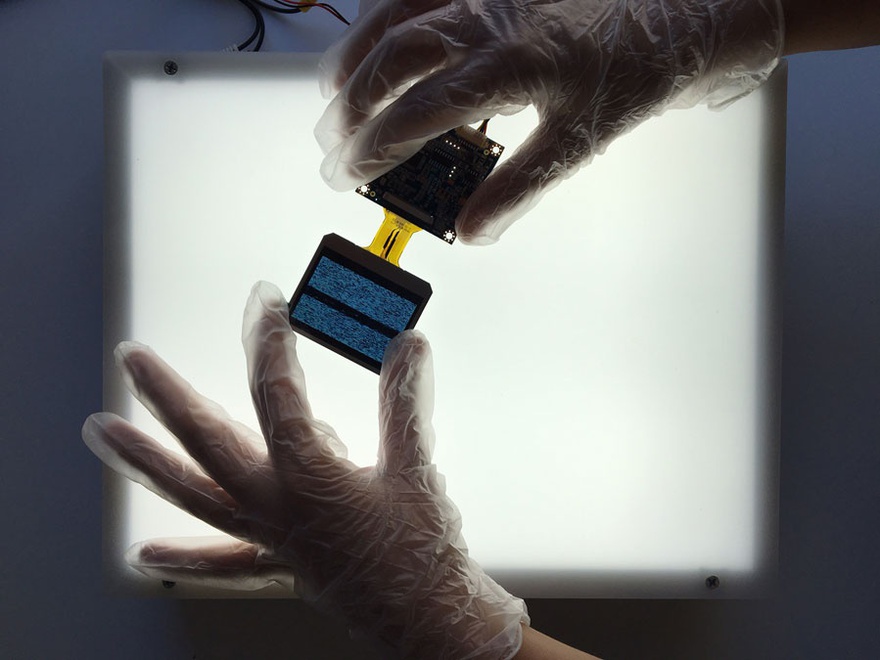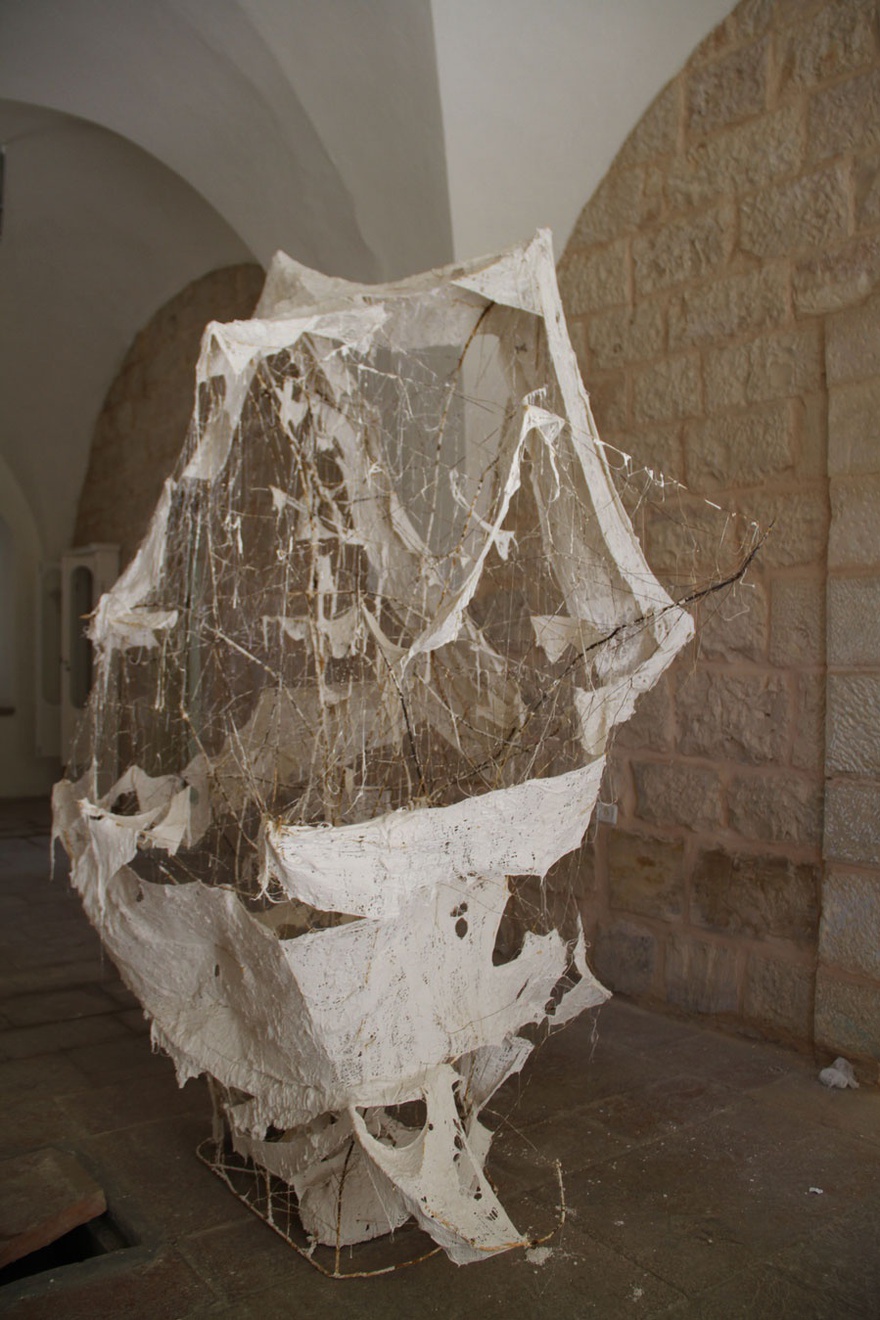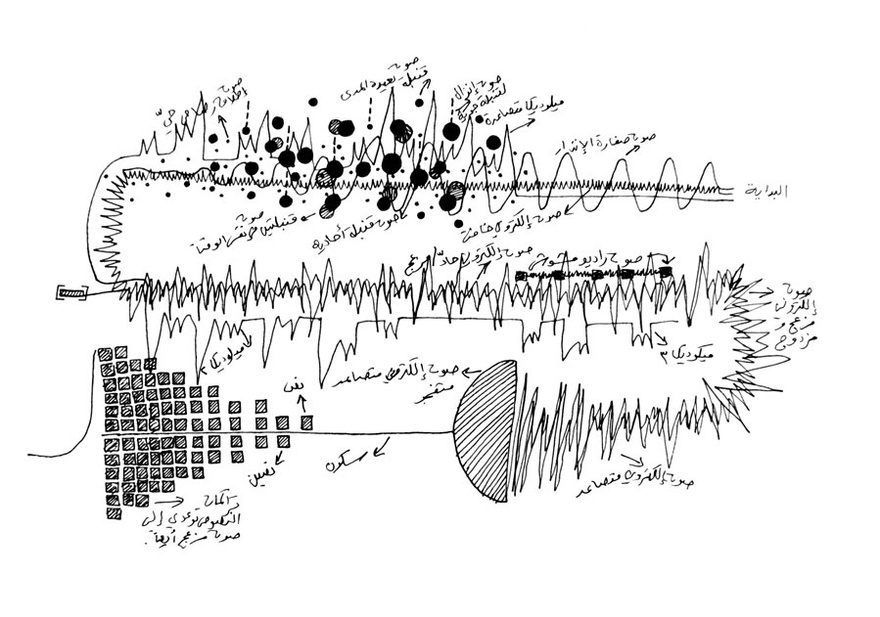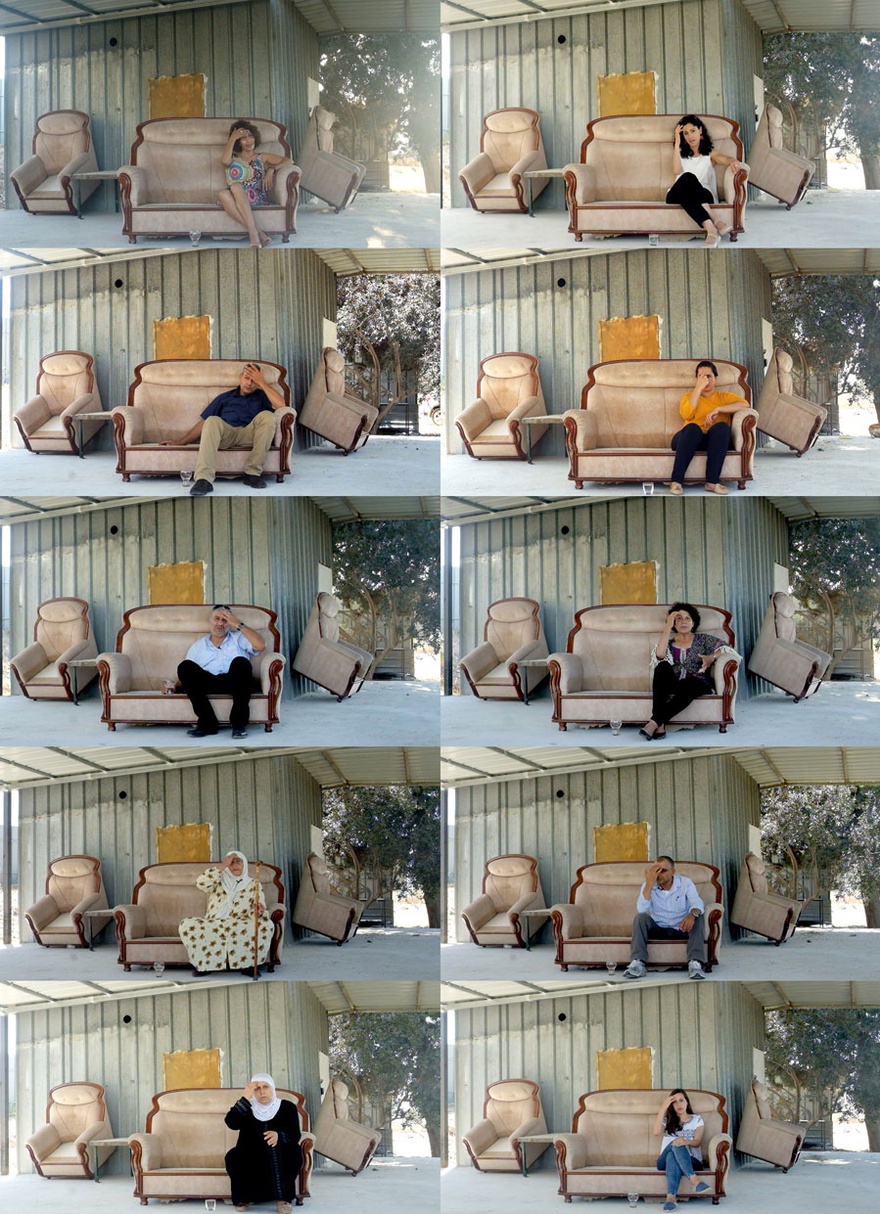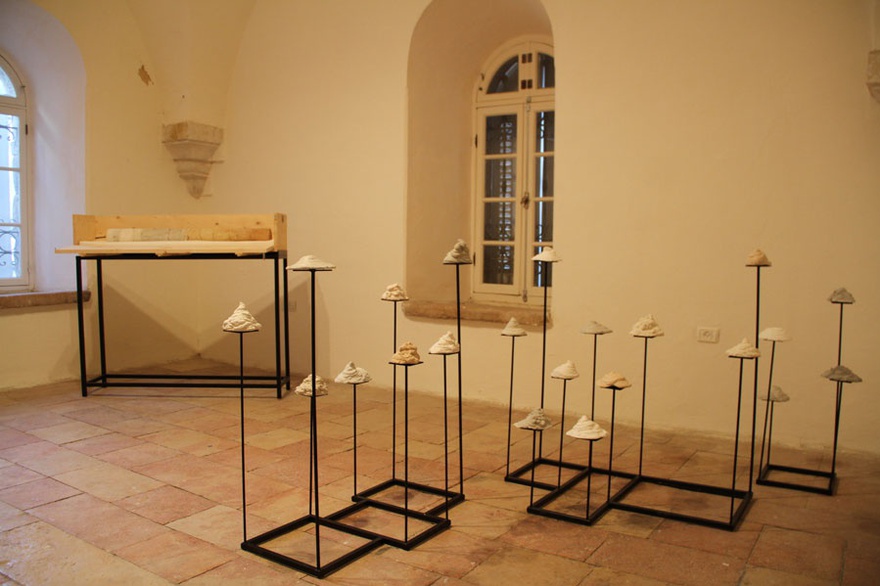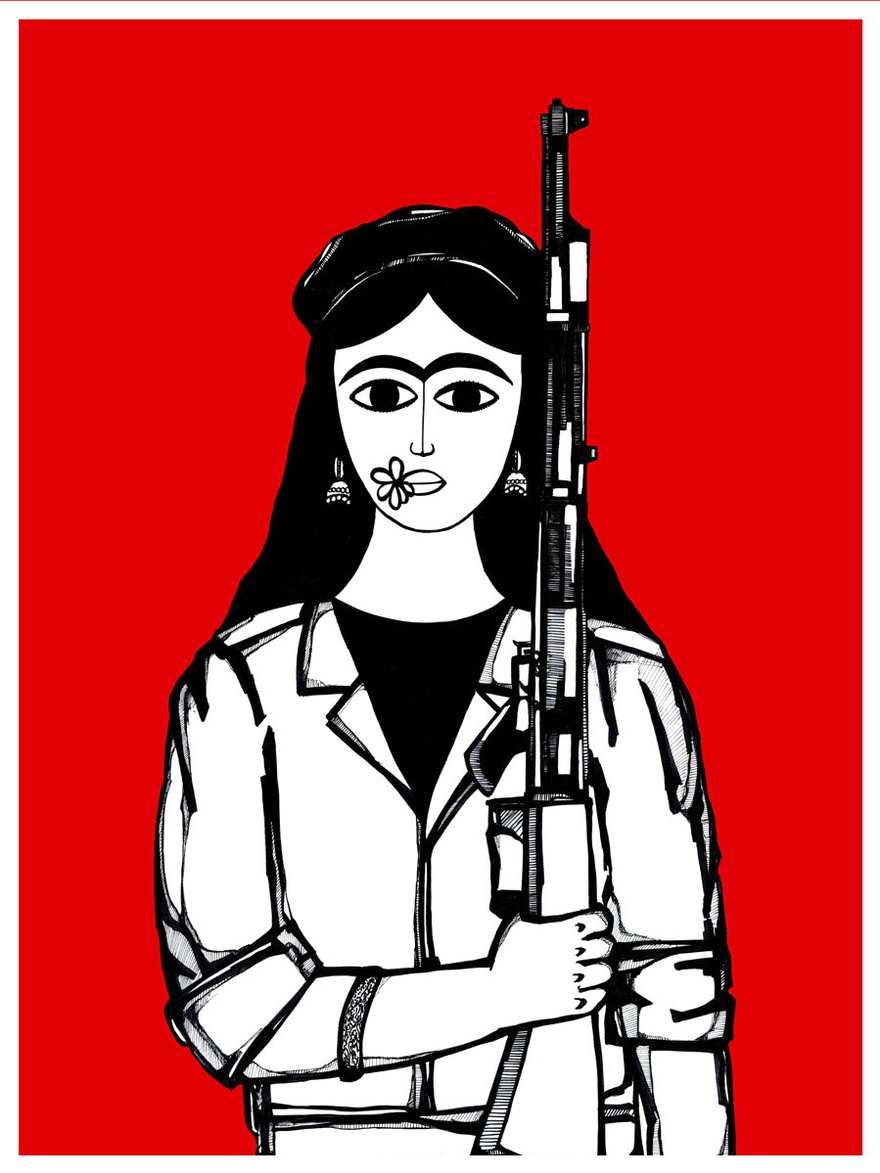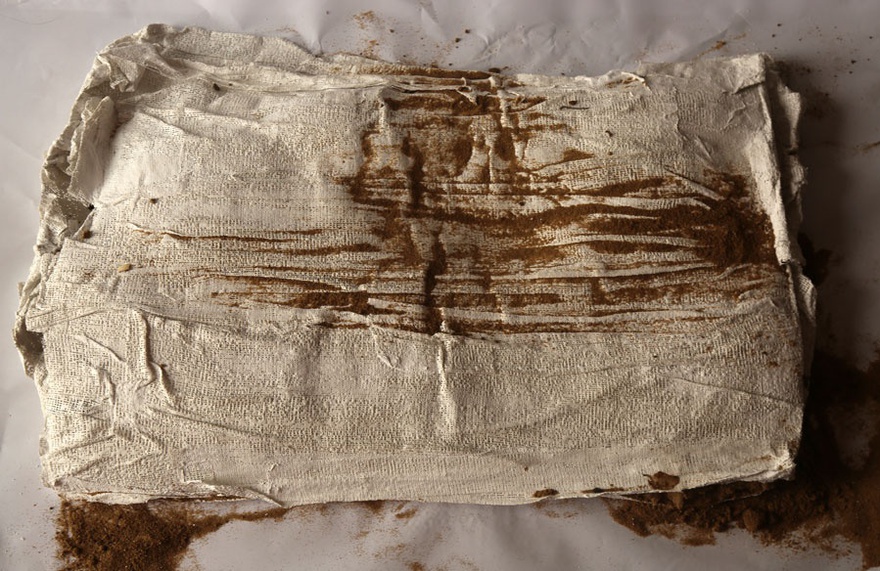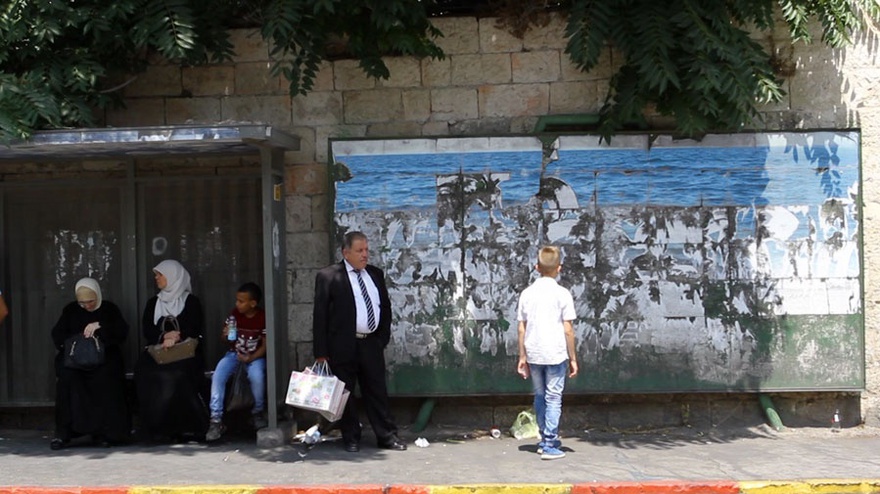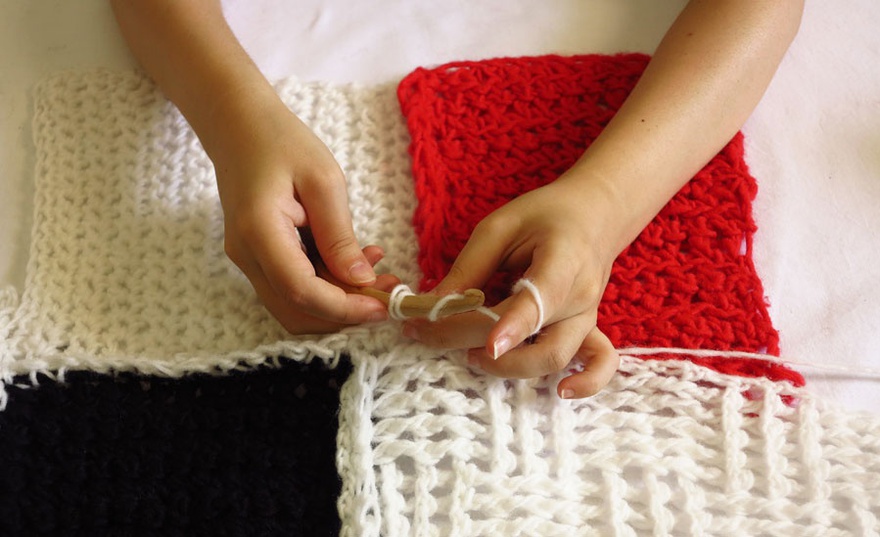Pattern Recognition
Location: Ramallah
Venue: Beit Saa, downtown Ramallah, in front of the Arab Bank.
Dates/Times: Daily from 12:00–18:00, except on Thursdays from 12:00–19:00.
On Thursdays, there will be a performance by Asma Ghanem at 19:00 at Beit Saa.
Closed on Fridays. Runs through 31 October, 2016.
Organizers: The A.M. Qattan Foundation
Curator: Nat Muller
Artists: Click on the names below to visit each artist's section
Noor Abed, Abdallah Awwad, Asma Ghanem, Inas Halabi, Aya Kirresh, Majd Masri, Majdal Nateel, Ruba Salameh, and Somar Sallam.
Click on the links below to visit each section
Curatorial Statement, by Nat Muller
Artist Projects
Artist Biographies
Curator Biography
Click here to download the full PDF programme for Pattern Recognition
Curatorial Statement
Nat Muller
Pattern Recognition brings together newly commissioned work from the nine artists shortlisted for the 2016 edition of the Young Artist of the Year Award (YAYA 2016). Developed over an intensive working period of five months, in close collaboration with the curator, this young generation of Palestinian artists present work that is rooted in the specificities of Palestinian locality, yet also transcends this. In a time of global uncertainties and polarization, which are amplified in Palestine, the artists have created works that combine politics with poetics and suss out certain patterns that define the unruliness of our present condition.
The projects in the exhibition explore how strategies of repetition open up avenues for critically rethinking issues of time, place, memory and authenticity. Straddling the grey zones between fact and fiction, original and copy, ruin and repair, the works re-imagine the mechanics of representation in the context of Palestine where geographies, histories and identities are fragmented.
Many of the works focus on how cycles of production are disturbed by forces that make things come undone. This continuous tension between creation and its unravelling functions as a metaphor for the Palestinian condition and as a conduit for the discussion of the complexities of the diverse Palestinian realities that these artists live and work in. It is from this reproduction and repetition of certain patterns that the artists reach out to the past and the future and trace a temporal lineage. In Pattern Recognition, repetition becomes a way to traverse different eras as well as an emancipatory tool for articulating an imaginary. This comes to the fore in the way the artists have edited their sound and video pieces, composed narrative structures, and how they have used imagery and material.
The works range from the very personal, such as Inas Halabi's video recording of a family history that is retold again and again, to the cool scientific forensics of Noor Abed's speculative sci-fi mystery. Witnessing and truth, these works suggests, are in the eye of the beholder. Bringing different timelines together, Aya Kirresh investigates the history of cement in Palestinian construction through a series of sculptural experiments, while Majd Masri traces how one iconographic image travels in different guises through Palestinian art history. Ruba Salameh unites the many impossibilities of Palestinian geography through nautical symbolism in her video piece. Others base their work on the convergence of construction and deconstruction, beginnings and endings. Majdal Nateel offers an accumulation of shattered dreams in her sculptural pillow installation. This resonates with Abdallah Awwad's wounded objects fashioned out of construction materials, Somar Salam's looped video of a quilt being woven and then pulled apart again, and Asma Ghanem's mesmerizing sound piece based on the sounds of war.
The exhibition takes place in Dar al Sa'a, a traditional house in the centre of Ramallah that was built in 1910 and restored two years ago. In its current form it combines its old origins with its renovated contemporary presence and function. It forms the perfect backdrop for a show that repetitively muddles up the notion of authenticity.
Noor Abed
Noor Abed, The Air Was Too Thin to Return the Gaze, 2016. Video stills.
Image courtesy of the artist.
The Air Was Too Thin to Return the Gaze, 2016
Video and mixed media installation
On 8 August 2015, a rumour spread of people sighting an unidentified flying creature over the village of Bir-Nabala, northwest of Jerusalem. As reported, the witness described the creature as 'long, partially transparent and somewhat familiar'. After some intensive research on the site, the artist found a technological device that contained an internal digital memory: flickering footage showing a first-person view from above. She immediately wondered if this object was an internal part of the floating creature or had been attached to it? And is it a memory of a time in the past or in the future? She became obsessed with this object, its implications of a displacement in time and with whom its gaze may have belonged. For the past year, the artist has been in residence at the Whitney Museum Conservation Research Laboratory in New York City, where she worked with specialists on analyzing the traces she had found.
This installation aims to share part of the ongoing research undertaken by the artist on the local sighting event. The work maps connections between the materiality of the digital image and the field of archaeology as an approach to study parallel realities of the found device and its memory. The found footage of a first-person view from above creates a displaced floating gaze while establishing an imaginary stable ground. Our constructed notions of perception are therefore blended with a tinge of the future; the work emphasizes a non-linear narrative and twists our traditional modes of seeing.
Abdallah Awwad
Abdallah Awwad, The Horizon’s Pathway, 2016.
Image courtesy the artist.
The Horizon's Pathway, 2016
Sculptures made from iron, wires, gypsum, fabric, silicon. 250 x 200cm and 200 x 130cm.
For 'The Horizon's Pathway' Abdallah was interested in stretching the properties and possibilities of various materials. Working instinctively, and through a repetitive methodology of trial and error, he produced two sculptures that not only highlight the fragility and ephemerality of the respective materials used (iron, wires, gypsum, fabric, silicon), but also their uncertainty of form. His sculptures look like wounded objects, ambivalent about whether they are in the process of becoming, or of coming apart. There seems to be an implicit violence in these sculptures that are bandaged, covered in rusty patches and dripping gypsum. It stands in stark contrast to the sculptor's otherwise delicate hand. Ghostlike in their presence, these nebulous forms stand witness to the uncertainty of our times.
Asma Ghanem
Asma Ghanem, Homeland is…, 2016.
Courtesy the artist.
Homeland is…, 2016
Live experimental music performance and printed notational score.
https://soundcloud.com/asma-ghanem/homeland-is
Homeland is… is an improvised sound performance that seeks to render audible the stagnation in, and the disillusionment with, the Oslo process that from 1993 was meant to lead to a negotiated agreement with Israel and which Palestinians thought would bring about an independent state. Asma asks whether we can think about this post-Oslo period musically. Palestine finds itself suspended between a nation-in-the-making and one under occupation. This sensibility is echoed in the performance by using sounds that, on the one hand, reflect silence and inertia (the stalled process of nation building), such as the stretched notes from the melodica, and, on the other, sounds of the occupation such as shelling, sirens, noise and gunshots. The rhythm of the piece oscillates between extreme slowness and rapid tempo, again reflecting the two states of being; as does the mix of faint and loud sounds, that range from the harmonically musical to electronic sounds and the din of war, together conveying a sense of confusion. The military sounds echo specific events that might trigger memories. The post-Oslo period has been primarily represented through images, but with this project Asma attempts to represent this contradictory period through experimental music as this genre expresses the complexity of the era best. The performance is based on a notational score, shown in the exhibition space, but the improvised elements modify each performance.
Inas Halabi
Inas Halabi, Mnemosyne, 2016.
Image courtesy the artist.
The title of this work, Mnemosyne, is borrowed from the Titan goddess of memory and the 'inventress of language and words'. The starting point for the project is a scar on the forehead of the artist's grandfather. The scar was a result of a bullet shot in his direction by an Israeli soldier in the late 1940s. Focusing on the sagas of myth and the construction of memory, members of the same family are filmed individually as they narrate their version of the same event. By scratching the surface of family history, the project explores the scar as a foundational hinge that arranges reality. The project also considers how one can play the role of a historian when the primary source is no longer there. 'We do not remember. We rewrite memory much as history is rewritten.'[1] As such, recollection becomes an act of transformation rather than reproduction.
[1] Chris Marker, Sans Soleil, 1983
كريس ماركر, Sans Soleil , ١٩٨٣
Aya Kirresh
Aya Kirresh, a concrete ode to history/معلّقات اسمنتيه , 2016.
Image courtesy the artist.
a concrete ode to history, معلّقات اسمنتيه, 2016
Cement, sand, various aggregate, earth, organic fibers, quick lime, brick powder, bonding additives and water
For decades, concrete has vastly dominated the architectural scene of Palestine. Our gaze is instantly captured by the overpowering presence of concrete, as its grey coat surrounds us from our warm homes to cold apartheid walls. Traditional Palestinian architecture is greatly defined by ancient, even pre-historic, techniques and building materials. By the 1950s new materials and technologies were revolutionizing the traditional way of building, but the traditional and the modern still overlap.
This work is research-based and produces a material and poetic timeline that visualizes the use of cement in Palestine. A Concrete Ode to History investigates diverse mortar mixtures, ranging from indigenous building materials (mud, clay, straw and other organic elements) dating from 8000-11000 BC, the more traditional building materials (lime, sand, gravel, crushed clay pottery, ashes and straw or other organic elements), to the modern building materials (cement, sand and variably sized aggregate). The work is a merger between reality and the imaginary, but also mirrors the actual built environment and the temporality of materials used in Palestine. A Concrete Ode to History was created by implementing a closed mechanized system of constants and variables, such as a funnel, the human body and various mortar mixtures. Each mixture is made from a precise ratio of building materials corresponding to a specific use in history or in the present time.
The work is performative in the sense that it involves a gesture of mechanized repetitions using different cement mixtures to produce unique outcomes. In one part of the installation the mixtures were allowed to freely form and take on their own character, resulting in autonomous sculptures as 'frozen fractions of time'. In the other part, the cement mixtures are layered harmoniously, and time is compressed and stratified within the framework of a cylinder. Both parts conform randomly and orderly to the temporal framework of the concrete history of Palestine.
Majd Masri
Majd Masri, Haphazard Synchronizations, 2016.
Image courtesy the artist.
Haphazard Synchronizations, 2016.
Acrylic on canvas, prints, collage, gun and jasmine flowers
Haphazard Synchronizations is an art historical journey through Palestinian art that explores how artistic practice and styles were affected by political and social events since the Nakba. The work focuses on the embodiment of the idea of struggle and land by using an iconic archival photo of a Palestinian female fighter in military fatigues with a flower between her lips, taken in the mid-1970s in a Palestinian refugee camp in Lebanon. The photo expresses both military strength as well as soft femininity. It also echoes a recurring trope in Palestinian art in which female figures are represented as mothers and signify the homeland. Drawing from the work of seminal Palestinian artists and artistic genres, the basic elements of the original photo (woman, flower, gun) is transformed into six iterations in specific artistic styles that mark corresponding periods within Palestinian political history. From Greek icon painting, graphic poster art from the PLO, to the visual language of prominent Palestinian artist Sliman Mansour and political cartoonist Naji al Ali, each work takes the spectator to a specific era with its own style, colours and mediums.
Majdal Nateel
Majdal Nateel, Dream Is Possible, 2016.
Image courtesy the artist.
Dream Is Possible, 2016
Installation of 26 pillows made from gypsum and earth
The installation materializes the concept of ‘return’ as an individual and collective dream that defines the Palestinian, and other refugee, experiences. A number of sleeping pillows are sculpted by hand from a gypsum mould and then filled with earth. The earth leaking through the pillows symbolises the strong connection Palestinians have to their homeland, as well as the dispossession and displacement they have suffered. Each pillow is an autonomous sculpture in and by itself, but together they represent the magnitude of a shared dream. Imperfect and cracked, these pillows are also testimony to the difficulty of keeping hope and dreams alive in the face of adversity.
Ruba Salameh
Ruba Salameh, يم / Ym / Yamm / (open sea), 2016.
Image courtesy the artist.
يم / Ym / Yamm / (open sea), 2016
Video, 19’16”
Yamm is a video work that captures Ruba Salameh's persistent return to a ready-made object – namely a bus stop in Salah Al-din Street in East Jerusalem – where a huge billboard print of the sea of Gaza stands out in its vast presence against waiting passengers and passersby. The fading paper, its wear and tear, the marks of time and human intervention, led to Ruba's recurrent attempts to document the object, haunted by the notion of its very disappearance.
The video captures the heart of everyday life in Jerusalem with as its background the remains of a still Gazan sea that is animated by an insertion of film fragments shot from the beach at Tantoura, a Palestinian village demolished in 1948. Shown in Ramallah, the work ties together the fragmentary nature of Palestinian geography: Gaza, the West Bank, Jerusalem and the territory of 1948. For many Palestinians, travelling the route of this very map has become an impossibility.
The image trapped within an image, that of the billboard and that of the street, positions us before possible narratives: collective and individual ones that tell of memory, loss, and of a scattered past in the act of waiting, choreographed within their natural order.
Somar Sallam
Somar Sallam, Disillusioned Construction, 2016.
Image courtesy the artist.
Disillusioned Construction, 2016
Video, 4'56".
The personal experience that Somar and her family are living along with thousands of other Palestinian-Syrian refugees who are displaced for the second time from their first place of asylum since the Nakba, may look like a duplication of the same tragedy endured by their grandparents. However, the time of peace in which they lived in their host country, where they had built and learned, and educated their children, was a period of disillusioned stability. It took them effort and time to rebuild their lives, only to see it destroyed because of the displacement and dispossession resulting from the ongoing war in Syria. Thus, they return to the point of departure.
Through a work of video art, Somar attempts to embody the processes of construction and coming apart through the means of crocheting a patchwork blanket. Hands and fingers perpetuate the same movement to create a woollen cover, composed of connected imperfect patches that use three colours: red, and black and white (referring to night and day). It becomes a cover for a body, which becomes exposed through the unravelling of the thread and the gradual destruction of the blanket. The labour of weaving together has come undone and the body loses its shelter and protection. All returns back to point zero.
Artist Biographies
Noor Abed (b. 1988, Jerusalem) received her BA from the International Academy of Arts Palestine, and her MFA from the California Institute of the Arts, Los Angeles. She has shown her work widely, in London, New York, Los Angeles, Norway, France, and in the Jerusalem Show V. From 2015–16 she was accepted onto the Whitney Museum's prestigious Independent Study Program in New York. Noor was joint winner of the 3rd prize in the 2014 Young Artist Award.
Abdallah Awwad (b. Nablus, 1987) graduated from the International Academy of Art Palestine in 2012. A participant in the Jericho 10,000 Years artists' workshop and Khalil Sakakini Cultural Center's Open Studio Residency Programme, he was recently invited to be part of the 'The Soul of Arts Calls for the World' event at the Dar Al Funoon Foundation in Morocco. Abdallah is based in Ramallah where he works with animation and childrens' books.
Asma Ghanem (b. 1991, Damascus) graduated from the International Academy of Arts Palestine and received her MA in audiovisual arts from ISDAT, Ecole des Beaux Arts de Toulouse, France. She has participated in exhibitions, residencies and workshops in Europe, the USA, the UAE, Lebanon, Jordan and Palestine. In 2014 she was awarded a production grant from the Arab Fund for Arts and Culture to produce her first experimental music album.
Inas Halabi has a BA from Bezalel Academy of Arts and Design in Jerusalem (2011), and an MFA from Goldsmiths, University of London (2014). Joint recipient of the 3rd prize in the 2012 Young Artist of the Year Award, her work has been shown internationally, in Palestine, Jordan, Switzerland and the UK. She has been living between Switzerland and Palestine, and was recently awarded a Mophradat production grant.
Aya Kirresh is a Palestinian Jerusalemite architect with a BSc in Architectural Engineering from Birzeit University (2013), and an MA from Kingston University, London (2014). Her work and research interests are in events in the public realm, amenities, space and interventions, using multimedia productions and publications. Aya has exhibited in London and Palestine, and was an artist-in-residence at Cittadellarte in Biella, Italy, in 2015. She teaches at the Palestine Polytechnic University.
Majd Masri (b. 1991, Jerusalem) graduated from Al Najah University in Nablus with a BA in painting and photography in 2013. She has participated in various workshops and group exhibitions, in Palestine, Norway and Denmark. Majd is a member of the administrative committee of the Young Artists Forum in Ramallah and the Palestinian Association of Artists.
Majdal Nateel (b. 1987) gained her BA in fine arts from Al-Aqsa University in Gaza. She has participated in various group exhibitions, and has had two solo exhibitions of her work in Gaza, 'Salt of Memory' (2012) and 'The Effect of Light and Glass' (2014). Majdal was also a finalist in the 2014 Young Artist Award. She has given workshops in drama, visual arts and animation, and been a teaching assistant in graphic design at the Gaza Community Training College.
Ruba Salameh (b. 1985, Nazareth) completed a BFA and MFA at the Bezalel Academy of Art and Design in Jerusalem (2013 and 2014). She has participated in artist-in-residence programmes, including in Aarau, Switzerland (2012), and her mixed media work dealing with identity, nostalgia, the individual and the collective, has been exhibited in Palestine, Milan, the Czech Republic and Hong Kong. Ruba lives and works in Jerusalem, where she has taught and led art workshops.
Somar Sallam (b. 1988, Damascus) graduated in fine arts from the University of Damascus in 2010. She has shown her work and been a participant in workshops, residencies and festivals in Syria, Lebanon and Algeria. Somar works as an illustrator for children's books and has had her illustrations published in children's magazines across the Arab world. An illustrated book she contributed to, Freelestine, won first prize at the International Comic Festival in Algeria in 2015.
Curator Biography
Nat Muller is an independent curator and critic based in Amsterdam. Her main interests include: the intersections of aesthetics, media and politics; media art and contemporary art in and from the Middle East. She is a regular contributor to Springerin, MetropolisM. Her writing has been published amongst others in Bidoun, ArtAsiaPacific, Art Papers, Hyperallergic, Canvas, X-tra, The Majalla, Art Margins and Harper's Bazaar Arabia. She has also written numerous catalogue and monographic essays on artists from the Middle East. With Alessandro Ludovico she edited the Mag.net Reader2: Between Paper and Pixel (2007), and Mag.net Reader3: Processual Publishing, Actual Gestures (2009), based on a series of debates organized at Documenta XII. She has taught at universities and academies in The Netherlands and the Middle East, and has curated video and film screenings for projects and festivals internationally, including for Rotterdam's International Film Festival, Norwegian Short Film Festival and Video D.U.M.B.O. She is a member of the Fund for Creative Industries and e-Culture's advisory committee (NL) as well as Amsterdam's municipal committee for artist studios. Previously she served as a member of selection committee of the Mondriaan Fund (NL).
In 2015 and 2016 Nat served as the Outreach Coordinator for the Prince Claus Fund. Recent projects include Spectral Imprints for the Abraaj Group Art Prize in Dubai (2012), Adel Abidin's solo exhibition I love to love… at Forum Box in Helsinki (2013), Memory Material at Akinci Gallery, Amsterdam (2014); Customs Made: Quotidian Practices & Everyday Rituals at Maraya Art Centre in Sharjah (2014); This is the Time. This is the Record of the Time at Stedelijk Museum Bureau Amsterdam & American University of Beirut Gallery (2014/15). Nat is editorial correspondent for Ibraaz and in 2012 was a speaker on BBC World's award-winning program The Doha Debates. In 2015 she curated a group show on contemporary Islamic miniatures Minor Heroisms for Galeri Zilberman (Istanbul) and Sadik Kwaish Alfraji's acclaimed solo show Driven by Storms (Ali's Boat) at Ayyam Gallery in Dubai for which she edited his first monograph, published by Schilt Publishing. In the same year she was Associate Curator for the Delfina Foundation's Politics of Food Program (London). In 2016 she edited Nancy Atakan's monograph Passing On published by Kehrer Verlag, and curated her solo show Sporting Chances at Pi Artworks (London). Her most recent show on the timely topic of loss of cultural heritage But Still Tomorrow Builds into My Face opened at Lawrie Shabibi Gallery during Art Dubai.
www.natmuller.com

